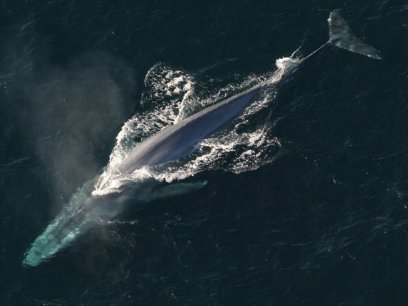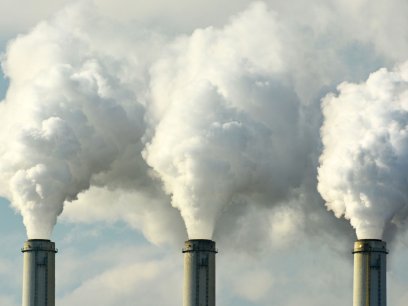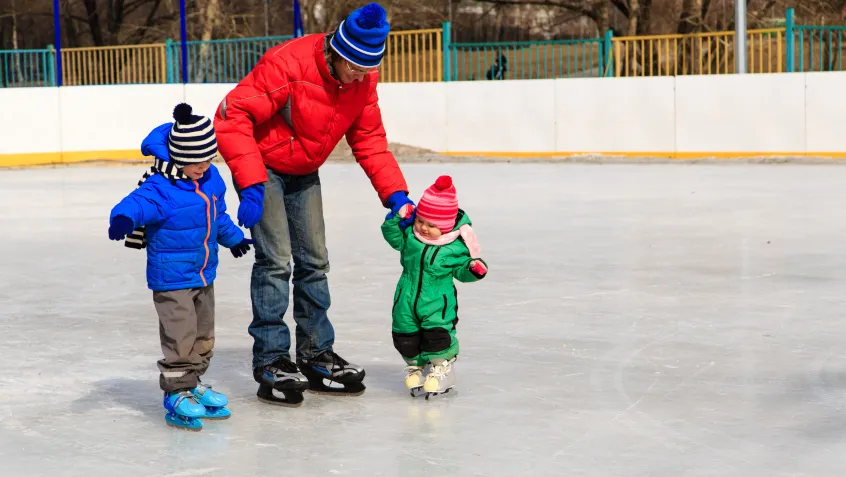
Did you know?
- Snow-based recreation contributes $67 billion annually and supports over 900,000 jobs in the United States.
- The Rocky Mountain region of the United States consistently records the highest total visitation rate in the US for snow sports; the Northeast is second.
- April snowpack in the Western United States has decreased by about 23% since 1955.
As air temperatures continue to rise and the winter season becomes shorter in the United States, the season for cold weather activities such as skiing, snowboarding, snowmobiling, outdoor ice hockey and skating, ice fishing, and winter hiking will also become shorter.
Snow Sports
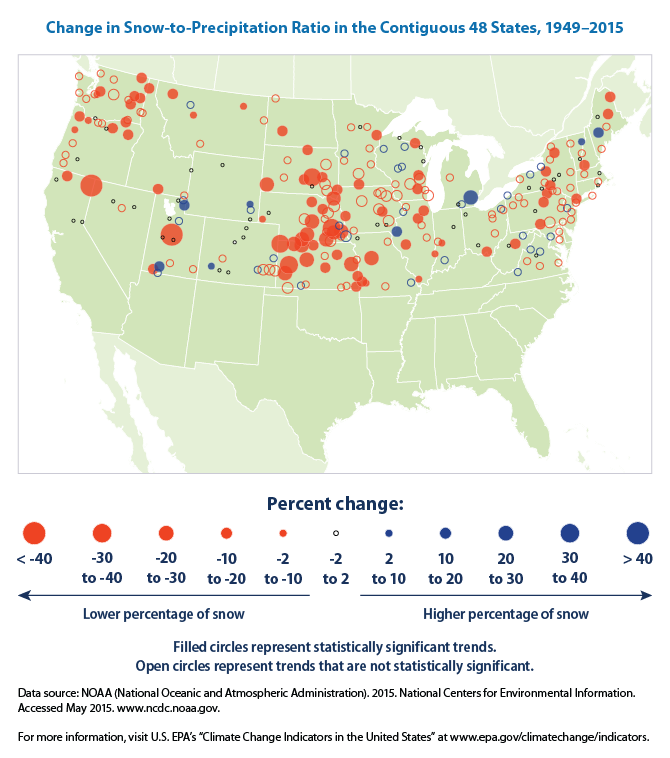
Since 1949, nearly 80% of weather stations across the contiguous 48 states have recorded an increase in winter precipitation falling as rain instead of snow. With a future projected increase in temperature and reduction in snow cover, snow sports such as skiing, snowmobiling, and snowshoeing may become limited.
For ski resorts in the Northeast to stay viable they require average ski season lengths of at least 100 days, nights cold enough to produce artificial snow, and snow during winter holidays when winter tourism is high. Projections indicate that most resorts in the region will be vulnerable by the end of the century because warmer temperatures will prevent them from meeting these criteria. As a result, resorts will be required to produce more artificial snow, likely resulting in increased resort attendance costs due to increased costs associated with water and energy usage.
Snowmobiling and cross country skiing are projected to be even more vulnerable. Machine-made snow has not typically been used to support these sports because it cannot produce enough snow to cover miles of trails.
Ice Sports
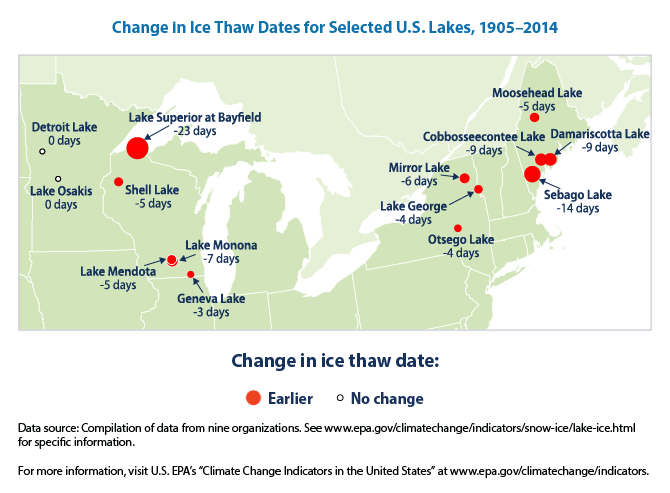
Freeze dates for Northern US lakes are occurring later in the year than they did in the past and thaw dates are occurring earlier, reducing the season for outdoor ice hockey and skating and ice fishing. Freeze dates are occurring at a rate roughly half a day to one day later per decade since 1905 and thaw dates have advanced up to 23 days earlier in the past 109 years.
The National Hockey League (NHL) has acknowledged in their 2018 NHL Sustainability Report that changing climates and increasing resource restraints adversely affects their sport. Mike Richter, NHL Green Ambassador and US Hockey Hall of Fame Goalie, has stated, "Our sport is affected by climate change more than any other. Our game was born on the frozen ponds of North America. The availability of free ice creates the culture we love. We want everyone to have access to our sport regardless of age or economic position. In order to do so, we need to preserve the outdoor rink."
Hiking on Public Lands
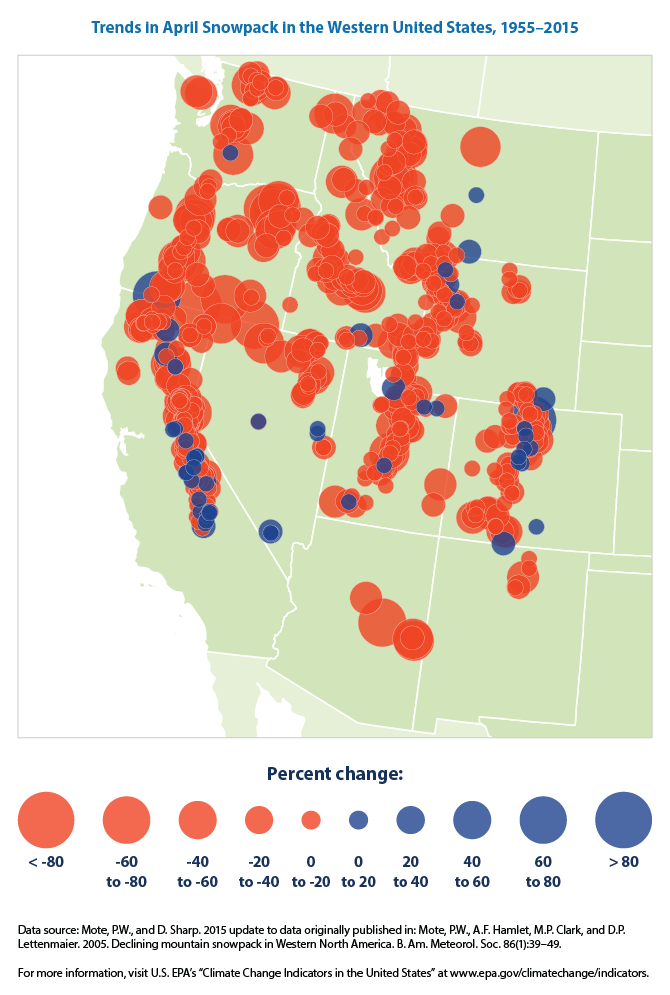
Snowpack attracts hikers and tourist throughout the year in many US National Parks, but decreases in snowpack have been observed in the western United States since 1955. In the winter, hikers are able to view snowcapped mountains and glaciers. As winters become warmer, the snowpack on top of mountains and the size of glaciers will decrease. For example, at Olympic National Park in Washington State, Blue Glacier on Mount Olympus lost three football fields in length between 1987 and 2010.
Warmer winters and decreased snowpack also impact the spring and summer hiking season, as there is less water for wildlife, plants, and humans living downstream. Yellowstone National Park now experiences approximately 30 fewer days per year with snow on the ground than there were in the 1960s. This has reduced the amount of spring snowmelt available to deliver freshwater that supports vegetation and wildlife such as migrating bison, spawning trout, and pollinators.
What You Can Do:
- NEEF is proud to partner with the NHL to Play it Forward. NHL is reducing its environmental impact to ensure that the sport of hockey thrives now and for future generations. Take a page from NHL’s playbook: Explore the Play it Foward inforgraphic and click on the linksto learn how you can bring some of the League’s sustainability strategies into your life.
- Join the NHL by taking action at home or at school to reduce your energy use. Conduct an energy audit to find out how much energy your electronics draw when they’re not in use. Then, make your own energy-saving plays to reduce your energy use and greenhouse gas emissions.
- Report the skating conditions of your outdoor rink with RinkWatch to help track winter climate trends and monitor the health of outdoor rinks.
Sources:
- Dawson, J., McBoyle, G., Scott, D.. 2009. “Climate change Analogue Analysis of Ski Tourism in the Northeastern USA”. Climate Research. Vol. 39: 1-9, June 2009. http://www.int-res.com/articles/cr2009/39/c039p001.pdf
- EPA. 2015. “A Student’s Guide to Global Climate Change: Recreation”. Accessed December 7. http://web.archive.org/web/20170127183703/http://www3.epa.gov/climatechange/kids/impacts/effects/recreation.html
- EPA. 2015. “Climate Change Indicators in the United States: Lake Ice”. Accessed December 7. http://www3.epa.gov/climatechange/science/indicators/snow-ice/lake-ice.html
- EPA. 2015. “Climate Change Indicators in the United States: Snowpack”. Accessed December 7. http://www3.epa.gov/climatechange/science/indicators/snow-ice/snowpack.html
- EPA. 2015. “Climate Impacts in the Northeast”. Accessed December 7. http://web.archive.org/web/20160501103235/http://www3.epa.gov/climatechange/impacts/northeast.html
- EPA. 2015. “Newsroom: EPA Administrator at X Games to Focus on Economic and Environmental Need to Act on Climate”. Accessed December 7. http://yosemite.epa.gov/opa/admpress.nsf/d0cf6618525a9efb85257359003fb69d/6787dc2a03fb440a85257dd3006087a2!opendocument
- NHL. 2018. “2018 NHL Sustainability Report”. Accessed January 22, 2019. http://ice.nhl.com/green/report/
- NHL. 2018. "Mike Richter's thoughts on preserving the outdoor rink." http://sustainability.nhl.com/report/#!/home/climate-change/mike-richte…;
- NPS. 2015. “Olympic Weather and Climate”. Accessed December 7. http://www.nps.gov/olym/planyourvisit/upload/weather.pdf
- NPS. 2015. “Yellowstone: Climate Change”. Accessed December 7. http://www.nps.gov/yell/learn/nature/climatechange.htm

